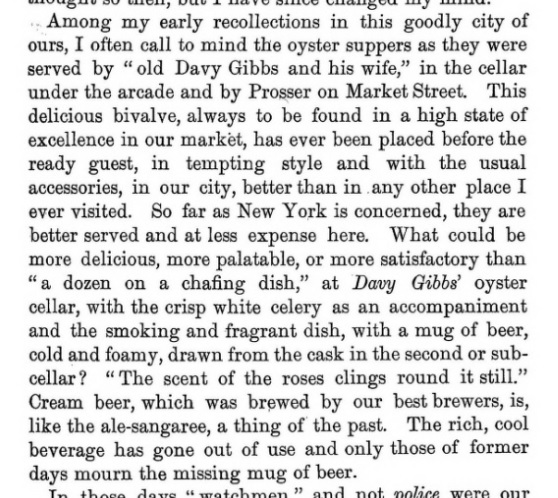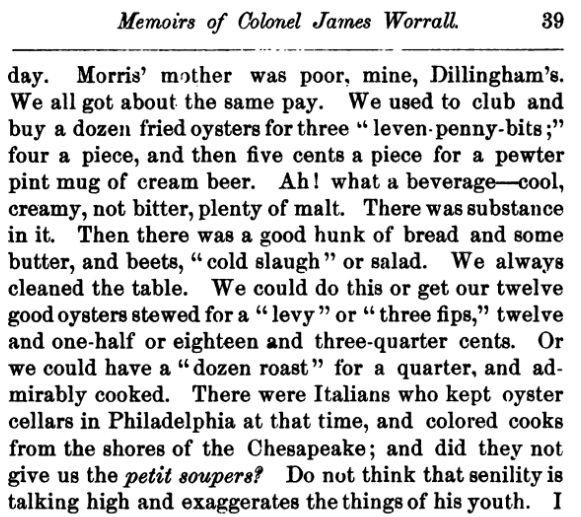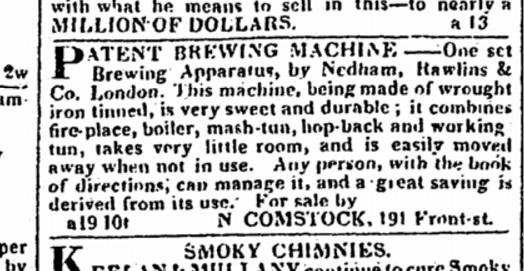 That is a notice placed in the New York American of 22 April 1825. Letters Patent were issued for the device in 1811 and 1812 (nos. 3493 and 3575 respectively). James Needham is listed as the inventor, described as a brewer in Islington a district of London, England. In a book whose title starts but is not completely stated as The Literary Panorama, being a Compendium of National Papers and Parliamentary Reports, illustratives of the History, Statistics and Commerce of the Empire… from 1811 we learn a bit more from the summary of that year’s patents:
That is a notice placed in the New York American of 22 April 1825. Letters Patent were issued for the device in 1811 and 1812 (nos. 3493 and 3575 respectively). James Needham is listed as the inventor, described as a brewer in Islington a district of London, England. In a book whose title starts but is not completely stated as The Literary Panorama, being a Compendium of National Papers and Parliamentary Reports, illustratives of the History, Statistics and Commerce of the Empire… from 1811 we learn a bit more from the summary of that year’s patents:
James Needham, Islington Green, Middlesex, Brewer and Corn Dealer, for a portable apparatus for brewing beer and ale.
Portable! How wonderful. In the same year’s publication of the Philosophical Magazine Series 1, Volume 38, Issue 163 it noted that the machine makes the beer from malt and hops and that the patent was issued on 23 September 1811. Curious as to the details? Well then get on your knees and thank God for the blessings imparted by The Repertory of Arts, Manufactures, and Agriculture: Consisting of Original Communications, Specifications of Patent Inventions, Practical and Interesting Papers, Selected from the Philosophical Transactions and Scientific Journals of All Nations, Volume 22 from 1813 which contains the entire four page declaration of the invention as submitted for the patent including diagrams:
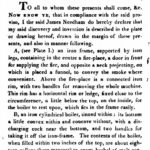
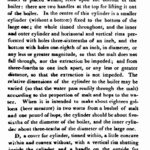
[Never mind the wheely thing to the left of the illustration. That’s the previous patent for Robert Bill’s clothes washing machine.] Needham’s application indicates that its standard operation was to make eighteen gallons from two worts drawn from a bushel of malt and a pound of hops. There is also references on the internets to an 18 page document published in 1813 entitled Directions for Brewing with Needham, Rawlins and Co.’s Patent Family Brewing Machine but I am not having any luck placing my hand upon a copy. In the April 1813 edition of The Tradesman an article sets out addition and improvements to the patent were described including these comments under the heading “Observations of the Patentee”:
The superior advantages of this machine, both in form and method of using it, are these. It unites the fire-place, copper, mash-tun, under-back, hop-back, and working-tun, in one compact portable utensil; simple in its construction, and convenient both in shape and the ease with which it is managed. It is made of tin: most durable and wholesome materials, and kept in order with little trouble. The method of brewing with the machine is easy and certain in its operation, and requires but little labour; the consumption of fuel is small, and the steam is condensed. It produces an abundant extract from both malt and hops, without the necessity of mashing; and the extract is also of a superior flavour, being obtained by a progressive degree of heat (from cold to boiling) given to the water, which infuses the malt and hops at one time in separate compartments of the vessel, yet affording an opportunity for the extracts to mix freely; thereby assimilating their component parts, fixing and preserving their essential and volatile particles, and thus completing the brewing in a few hours. The wort obtained by this process is so congenial to fermentation, as to produce (after a short time keeping in the cask) a transparent and highly-flavoured malt liquor, superior in quality to any that can be produced by other methods.
So, the miracle that Needham blessed us with was the idea of no mash
home brewing. Sounds all a bit dodgy to me. And who is Rawlins? Bet he was the money man. He shows up in 1813 given that the 18 page directions booklet carries his name. The booklet is described in this list of cookery books acquired by Princeton University in 2012 including a passage from the preface:
NEEDHAM, RAWLINS and CO. Directions for Brewing with Needham, Rawlins, and Co.’s Patent Family Brewing Machine. Printed for the Patentees, and Sold by them at their Warehouses, Skinner Street, London; and Narrow Wine Street, Bristol. And by all their Agents. Sixth Edition. 8vo. 18pp., folding frontispiece with engravings of the machine and letterpress text, a single leaf on different paper with a list of agents for the machine around the country (printed by W. Newman, Widegate-st. Bishopsgate”. Stitched as issued in contemporary buff wrappers, uncut (wrappers slightly soiled). London: by T. H. Coe, 1813.
“Malt liquor has ever been considered in this country a Constitutional Beverage, and the advantages of private brewing were at all times sufficiently obvious, by the reducing it effected in the cost, and the pleasure of having Beer of any strength required; but the inconveneience and uncertainty attendant on it, have prevented its general adoption. To avoid these difficulties, by a Compact, Portable Brewing Apparatuus, which should embrace the more important object of producing superior Malt Liquor, has been the devoted study of the inventors of this Machine, which removes all uncertainty in Brewing (an object that has eluded the attentive search of the most scientific Brewers); requires but little labour, and obtains a greater extract from both Malt and Hops, without the necessity of mashing, a tedious and inconvenient operation.” (Preface).
Beer was a household staple in an age when the water was very likely to be poisonous – even schoolchildren were allowed a ration of “small” or weak beer – and it also had the advantage of keeping the servants out of the public houses. Intererstingly, home brewing was closely allied to the temperance movement in Victorian times. Charles Edward Rawlins left the partnership with James Needham and Joseph Rawlins on 31 December 1813 (London Gazette).
Too bad for Princeton that the booklet was published a quarter century before the Victorian era started. And, well, that last bit is interesting. Two Rawlins had been involved, one* leaving fairly early on even though they seemed to be on a roll with six editions of the booklet, warehouses as well as agents. Sadly – or maybe not so sadly depending on the beer – it didn’t pan out all that well for these gents in the longer term. Just fifteen years after publishing the improvements and directions – and three years after some guy in New York was flogging off his equipment second hand – it seems to have all come apart. In the 2 May 1828 edition ofThe London Gazette, the official journal of government notices and proclamations, we see the following notice at page 855:
Sic transit gloria the idea of no mash home brew. Notice that while Needham became a hop merchant in Southwark he had to assign his entire estate to Rawlins and another, a stock broker by way of Medley. Someone lost all they had over this matter. Maybe they all did.
Monday Update: An excellent and unexpected bonus. Four more images related to Needham.
To the far left is an ad for the machine from The Cambrian, a Welsh newspaper, from 21 November 1812. Next, is the notice stating that Charles Edward Rawlins had had enough and was out of the partnership. Middle right is the actual front page of the user guide and, far right, a 1821 book entitled Domestic Brewer and Family Wine-Maker which seems to have the user guide incorporated into it. Fabulous stuff.
*The departing partner, Charles Edward Rawlins, was a soda-water manufacturer on that same Narrow Wine Street in Bristol in 1814.


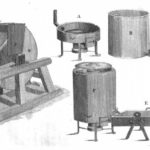
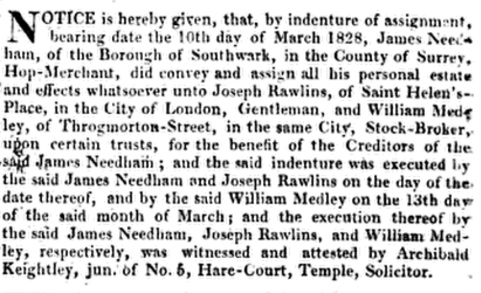
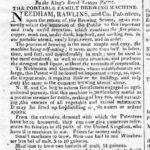


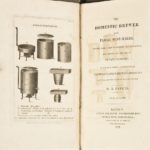
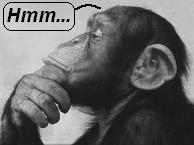 Ah, Mr. Chimphead. A serious point must be about to be made. But being August, there is not much out there to read, not much worth writing about. People rightly have other things to do. But Bryan Roth has posted a
Ah, Mr. Chimphead. A serious point must be about to be made. But being August, there is not much out there to read, not much worth writing about. People rightly have other things to do. But Bryan Roth has posted a 



